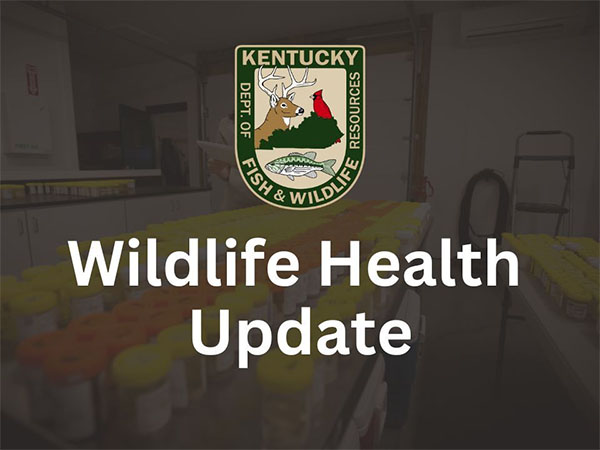Officials with the Kentucky Department of Fish and Wildlife Resources announced today that Kentucky has joined the list of states across the country with a confirmed detection of Chronic Wasting Disease (CWD), a fatal neurologic disease that affects deer, elk and other species in the deer family.
Two independent types of tests were performed on tissue collected from a 2.5-year-old male white-tailed deer that was harvested by a hunter in Ballard County in November. Both tests yielded the same test result: the deer was infected with the abnormal proteins that cause CWD.
It is Kentucky’s first documented case of the disease.
While no conclusive evidence exists that CWD can be transmitted to people, the Centers for Disease Control and Prevention (CDC) recommends refraining from eating meat from animals that test positive for CWD. Kentucky Fish and Wildlife always advises against eating the meat from game animals that appear sick or in poor condition.
Deer that appear to be sick but do not have an obvious injury can be reported using the department’s sick deer online reporting form; reports will be reviewed by the agency’s wildlife health program staff, who will contact the person submitting the report if additional information is needed.
As Kentucky Fish and Wildlife staff continue to gather additional details about the infected deer, agency officials are in close communication with national, state and local partners as they carefully consider next steps in response to the detection.
“We at Kentucky Fish and Wildlife hoped this day would never come but we have been preparing for it,” Kentucky Fish and Wildlife Commissioner Rich Storm said. “Our team of experts first developed our CWD Response Plan more than 20 years ago, and it has been enhanced through the years using the best available science.
“Collaboration with our many partners, including hunters, taxidermists, meat processors, diagnostic testing facilities and other government agencies has enhanced our CWD surveillance efforts.”
The deer was harvested on opening day of modern gun deer season. Biologists collected tissue from the animal as part of ongoing CWD surveillance efforts.
Preliminary tests were conducted at Murray State University’s Breathitt Veterinary Center, where the Enzyme-Linked Immunosorbent Assay (ELISA) CWD test identified the sample as a suspect positive.
Following its CWD Response Plan, Kentucky Fish and Wildlife immediately sent back-up samples to the National Veterinary Services Laboratories (NVSL) in Ames, Iowa for an expedited Immunohistochemistry (IHC), which is a test that is used to detect the deposition of infectious abnormal proteins within specific cervid tissues.
“Results from the IHC confirmed the results of the initial ELISA test and were reported to us on Wednesday as a CWD detection,” said Dr. Christine Casey, wildlife veterinarian with Kentucky Fish and Wildlife. “The combination of the ELISA test and IHC gives us the utmost confidence that the animal was infected with the disease.”
Since its discovery in the late 1960s in Colorado, CWD has spread to more than half the states in the U.S., including six of seven Kentucky-bordering states (Missouri, Illinois, Ohio, West Virginia, Virginia and Tennessee).
Early detection is critical to slowing the spread of this disease, which can be transmitted through direct contact between animals such as shared body fluids or from plants and soil in a contaminated area. Infected deer can transmit the disease even if they are not currently showing symptoms.
Kentucky Fish and Wildlife established its CWD Response Plan after the disease was detected for the first time east of the Mississippi River, and it has evolved through the past 20-plus years.
The department activated the plan in September 2021 following an announcement by the Tennessee Wildlife Resources Agency that the disease was found just across Kentucky’s southern border in northwestern Tennessee.
Kentucky Fish and Wildlife subsequently established a CWD Surveillance Zone in western Kentucky, encompassing Calloway, Marshall, Graves, Fulton and Hickman counties. Special regulations remain in place for those counties.
Kentucky Fish and Wildlife operated mandatory CWD check stations in the surveillance zone in 2021, 2022 and again this year during the first three days of modern gun deer season (Nov. 11-13).
The department collected 1,318 samples last month at its CWD check stations in western Kentucky. Currently, it has received results from 84 percent of those samples, and 35.6 percent of results from samples collected statewide.
Ballard County is adjacent to the surveillance zone. Kentucky Fish and Wildlife staff have been collecting samples from the county for many years as part of the agency’s statewide surveillance efforts, but the disease had never previously been detected.
Since 2002, Kentucky Fish and Wildlife has CWD-tested more than 40,000 deer and elk from across the state, sampling every county.
“Although CWD is always fatal to infected individual animals, by following best practices we can minimize its impact on the long-term health and sustainability of our deer herd so that we can continue to enjoy our deer and elk herds for many generations to come, helping to safeguard the many ways that they benefit the Commonwealth,” Storm said.
With more than a month before deer hunting closes for the season in Kentucky, hunters can aid Kentucky Fish and Wildlife’s statewide monitoring efforts by donating the heads of legally harvested and telechecked deer for CWD testing and aging through the voluntary Deer Sample Collection Station program. There is no cost to hunters. Location information, instructions and more information about the program are available online via fw.ky.gov/cwd. If a hunter-harvested deer tests positive for CWD, the hunter will be contacted upon confirmation of the disease.
For the latest information on CWD, please visit the department’s website and follow its social media channels. More information about CWD is available at fw.ky.gov/cwd, cwd-info.org and through the CDC website.
Kentucky Department of Fish and Wildlife Resources























